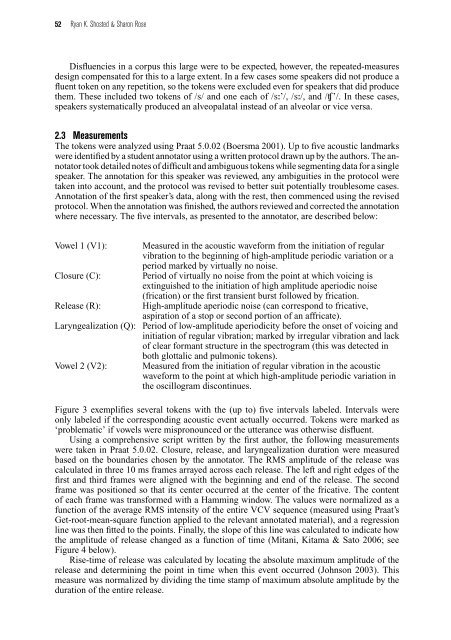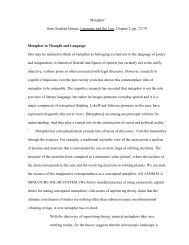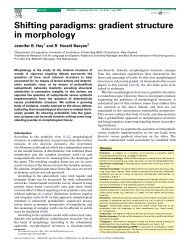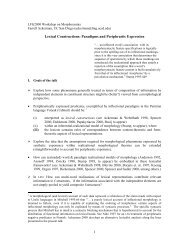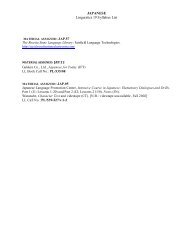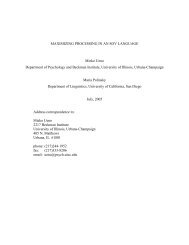Affricating ejective fricatives: The case of Tigrinya - Linguistics
Affricating ejective fricatives: The case of Tigrinya - Linguistics
Affricating ejective fricatives: The case of Tigrinya - Linguistics
You also want an ePaper? Increase the reach of your titles
YUMPU automatically turns print PDFs into web optimized ePapers that Google loves.
52 Ryan K. Shosted & Sharon RoseDisfluencies in a corpus this large were to be expected, however, the repeated-measuresdesign compensated for this to a large extent. In a few <strong>case</strong>s some speakers did not produce afluent token on any repetition, so the tokens were excluded even for speakers that did producethem. <strong>The</strong>se included two tokens <strong>of</strong> /s/ and one each <strong>of</strong> /s˘’/, /s˘/, and /’/. In these <strong>case</strong>s,speakers systematically produced an alveopalatal instead <strong>of</strong> an alveolar or vice versa.2.3 Measurements<strong>The</strong> tokens were analyzed using Praat 5.0.02 (Boersma 2001). Up to five acoustic landmarkswere identified by a student annotator using a written protocol drawn up by the authors. <strong>The</strong> annotatortook detailed notes <strong>of</strong> difficult and ambiguous tokens while segmenting data for a singlespeaker. <strong>The</strong> annotation for this speaker was reviewed, any ambiguities in the protocol weretaken into account, and the protocol was revised to better suit potentially troublesome <strong>case</strong>s.Annotation <strong>of</strong> the first speaker’s data, along with the rest, then commenced using the revisedprotocol. When the annotation was finished, the authors reviewed and corrected the annotationwhere necessary. <strong>The</strong> five intervals, as presented to the annotator, are described below:Vowel 1 (V1):Closure (C):Release (R):Measured in the acoustic waveform from the initiation <strong>of</strong> regularvibration to the beginning <strong>of</strong> high-amplitude periodic variation or aperiod marked by virtually no noise.Period <strong>of</strong> virtually no noise from the point at which voicing isextinguished to the initiation <strong>of</strong> high amplitude aperiodic noise(frication) or the first transient burst followed by frication.High-amplitude aperiodic noise (can correspond to fricative,aspiration <strong>of</strong> a stop or second portion <strong>of</strong> an affricate).Laryngealization (Q): Period <strong>of</strong> low-amplitude aperiodicity before the onset <strong>of</strong> voicing andinitiation <strong>of</strong> regular vibration; marked by irregular vibration and lack<strong>of</strong> clear formant structure in the spectrogram (this was detected inboth glottalic and pulmonic tokens).Vowel 2 (V2):Measured from the initiation <strong>of</strong> regular vibration in the acousticwaveform to the point at which high-amplitude periodic variation inthe oscillogram discontinues.Figure 3 exemplifies several tokens with the (up to) five intervals labeled. Intervals wereonly labeled if the corresponding acoustic event actually occurred. Tokens were marked as‘problematic’ if vowels were mispronounced or the utterance was otherwise disfluent.Using a comprehensive script written by the first author, the following measurementswere taken in Praat 5.0.02. Closure, release, and laryngealization duration were measuredbased on the boundaries chosen by the annotator. <strong>The</strong> RMS amplitude <strong>of</strong> the release wascalculated in three 10 ms frames arrayed across each release. <strong>The</strong> left and right edges <strong>of</strong> thefirst and third frames were aligned with the beginning and end <strong>of</strong> the release. <strong>The</strong> secondframe was positioned so that its center occurred at the center <strong>of</strong> the fricative. <strong>The</strong> content<strong>of</strong> each frame was transformed with a Hamming window. <strong>The</strong> values were normalized as afunction <strong>of</strong> the average RMS intensity <strong>of</strong> the entire VCV sequence (measured using Praat’sGet-root-mean-square function applied to the relevant annotated material), and a regressionline was then fitted to the points. Finally, the slope <strong>of</strong> this line was calculated to indicate howthe amplitude <strong>of</strong> release changed as a function <strong>of</strong> time (Mitani, Kitama & Sato 2006; seeFigure 4 below).Rise-time <strong>of</strong> release was calculated by locating the absolute maximum amplitude <strong>of</strong> therelease and determining the point in time when this event occurred (Johnson 2003). Thismeasure was normalized by dividing the time stamp <strong>of</strong> maximum absolute amplitude by theduration <strong>of</strong> the entire release.


